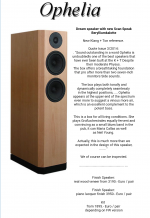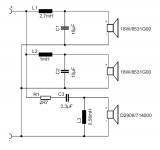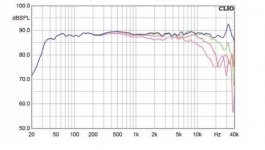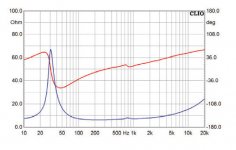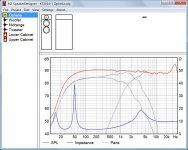Has anyone built the Scan-Speak Ophelia MMT speakers? Any idea how it sounds? Any apparent issues?
Drivers:
18W/8531G00 (2)
D2908/71400 Beryllium
Specs:
Crossover: 2nd order, 2.5-way
SPL: 89dB/W
I have all the drivers and all the crossover parts - Jantzen wax foil coils, Mundorf Supreme Caps for the 18W drivers, and Jupiter Copper for the 71400 tweeter cap.
I'm planning to use 65L cabinets instead of 73L.
Thanks
Drivers:
18W/8531G00 (2)
D2908/71400 Beryllium
Specs:
Crossover: 2nd order, 2.5-way
SPL: 89dB/W
I have all the drivers and all the crossover parts - Jantzen wax foil coils, Mundorf Supreme Caps for the 18W drivers, and Jupiter Copper for the 71400 tweeter cap.
I'm planning to use 65L cabinets instead of 73L.
Thanks
Attachments
Last edited:
2.5 way when I am right.
Second order filters; midwoofer en tweeter connected in phase, is that correct?
Second order filters; midwoofer en tweeter connected in phase, is that correct?
2.5 way when I am right.
Second order filters; midwoofer en tweeter connected in phase, is that correct?
2.5 way? Yes.
Second order electrical filters? Yes.
Everything connected with positive going polarity? Yes.
My main issue with this loudspeaker is that the xover between the tweeter and woofers appears to be rather high in frequency. It's not terrible, but you've got the classic wide-narrow-wide dispersion profile showing through as you go further off axis.
This tweeter is a beast and can certainly handle crossing over lower to help reduce this as a problem.
I'm planning on following the above crossover without changes, unless someone has a better solution. 🙂 The crossover is simplistic - a 2.5-way, 2nd-order, in phase. The crossover points are 1kHz for the first woofer, and 2kHz for the second woofer/tweeter.
The 71400 has decent wide dispersion characteristics, like the 66000, and 71000 tweeters. These don't exhibit the lesser dispersion patterns of the ring radiators like 83200 and 70000.
For power distribution, I could live with a crossover point of 2kHz. Sure, 1.7kHz would've been better for dispersion, as it can certainly handle more power. I'd have a problem if it were high like 2.2kHz or 2.8kHz. Besides, the 18W/8531G00s are smooth and easy on crossovers, with no nasties of cone break-up, nor any beaming issues.
So, has anyone built it, or heard it?... I'm asking because I have 3 projects that are quite similar in the pipeline. I'm looking for assurance that this project is free without major problems. I have the Ellam D'Appo, 5.25" MTM, and also a SBA Satori 6.5" + Be MTM on the shelf to be built.
The 71400 has decent wide dispersion characteristics, like the 66000, and 71000 tweeters. These don't exhibit the lesser dispersion patterns of the ring radiators like 83200 and 70000.
For power distribution, I could live with a crossover point of 2kHz. Sure, 1.7kHz would've been better for dispersion, as it can certainly handle more power. I'd have a problem if it were high like 2.2kHz or 2.8kHz. Besides, the 18W/8531G00s are smooth and easy on crossovers, with no nasties of cone break-up, nor any beaming issues.
So, has anyone built it, or heard it?... I'm asking because I have 3 projects that are quite similar in the pipeline. I'm looking for assurance that this project is free without major problems. I have the Ellam D'Appo, 5.25" MTM, and also a SBA Satori 6.5" + Be MTM on the shelf to be built.
Last edited:
In my experience with the 8531, I was not all that happy with it in Zaph's ZRT 2.5. Different crossover but still 2nd order 2.5way.
I have now switched to an active 2 way using LR4 crossover which I find is better. Now that I am active, I have tried various crossover points and find that the 8531 does not sound right in the upper end which may be why I find LR4 sounds nicer. Using anywhere from 1600 to 2200 LR4 seems to all sound nice to me.
That's all IMO though. Most people seem to think the 8531 (& 4531) are excellent even though a lot of designs are using them with 2nd order crossovers.
I have now switched to an active 2 way using LR4 crossover which I find is better. Now that I am active, I have tried various crossover points and find that the 8531 does not sound right in the upper end which may be why I find LR4 sounds nicer. Using anywhere from 1600 to 2200 LR4 seems to all sound nice to me.
That's all IMO though. Most people seem to think the 8531 (& 4531) are excellent even though a lot of designs are using them with 2nd order crossovers.
In my experience with the 8531, I was not all that happy with it in Zaph's ZRT 2.5. Different crossover but still 2nd order 2.5way.
I have now switched to an active 2 way using LR4 crossover which I find is better. Now that I am active, I have tried various crossover points and find that the 8531 does not sound right in the upper end which may be why I find LR4 sounds nicer. Using anywhere from 1600 to 2200 LR4 seems to all sound nice to me.
That's all IMO though. Most people seem to think the 8531 (& 4531) are excellent even though a lot of designs are using them with 2nd order crossovers.
Thanks merlinx76 for sharing your experience with the 18W/8531G. As an experiment, I only used an active filter for high pass application to accompany on my 2.5-way eVeII speakers (Scan-Speak 22W/18W/98000 classic drivers) by mating it to a low-pass sub. It didn't sound natural. Maybe it might have been the D/A conversion on the Behringer, I don't know. So, I've avoided active crossovers ever since. I do have a Rane 23Xover and Behringer DCX-2200, which would be fairly easy to experiment to actually see how different crossover points may actually sound in an M + T set up.
The 18W/8531G00 may not produce the dynamic impact and resistance to compression as the 18WU/8741T00, but I've heard the midrange may be sweeter on the 18W/8531G. I do have the 18WU/8741T in an actual 3-way with a 13" driver and the SS 66000 tweeter, and the low level detail, imaging, and dynamics are stellar - much more than the 18W/8545 classic 7" driver in my eVeII.
It's a pain to make cabinets - very time consuming! I wish I could get advance notice of the Ophelia's sound. I'll be using high-end caps, maybe it'll be OK...
Do they have the full 6dB boost? Seems a bit overkill with those drivers. A large room is a must
I'm going with 65L, instead of 73L as the drawing indicate. Besides, I can tune the port low if bass is an issue. Bass has never been an issue in this room with other speakers I've made like 8' 2.5-ways, and 13" 3-ways - the room just swallows bass. The room measures 23'x24'.
I guess if these speakers are lousy, I can use the four 18W/8531G woofers and make an Troels design - Ekta Grande. But, I'm not a fan of the 83200 and 70000 ring radiator tweeters.
Last edited:
My take on 2.5ways is that they are useful with smaller midbass designs, esp when crossing to a ribbon. Not sure of the merits of larger 2.5s
There are plenty of threads on the zaph 2.5, on several forums
There are plenty of threads on the zaph 2.5, on several forums
Last edited:
Thanks, Bill! I'm almost done with Troel's Ellam D'Appo, and I have the ATS-4 kit on the shelf. I wanted an easier project in the meantime. Most of these Zaph 2.5-ways are 2nd order woofer with 3rd order tweeter which adds 90-deg phase shift to work on flat front baffles. Speakers sound best with LR2 filters and with tilted/stepped baffles.My take on 2.5ways is that they are useful with smaller midbass designs, esp when crossing to a ribbon. Not sure of the merits of larger 2.5s
There are plenty of threads on the zaph 2.5, on several forums
However, the Ophelia is 2nd order for the tweeter on a flat baffle. I wonder if it will benefit from a stepped or tilted baffle. I'm thinking that the crossover may be too simplistic in this regard?..
Ah, good to know. I tried to google the crossover for the ZRT 2.5, and a few images came up with 2nd/3rd order networks... Perhaps those are unrelated to the the actual ZRT 2.5 network.The ZRT 2.5 is also 2nd order on the woofer and tweeter even though it's flat baffle.
Ah, good to know. I tried to google the crossover for the ZRT 2.5, and a few images came up with 2nd/3rd order networks... Perhaps those are unrelated to the the actual ZRT 2.5 network.
Yeah he did a 2nd/3rd order on the 2-way with a single woofer, but the 2.5way has 2nd/2nd. http://zaphaudio.com/ZRT-2.5way-crossover.gif
Thanks merlinx for the crossover. Definitely more LCR correction on the ZRT 2.5-way. Perhaps cone break or impedence correction. I might just do a quick and dirty set up to test it out the Ophelia on a flat front baffle.Yeah he did a 2nd/3rd order on the 2-way with a single woofer, but the 2.5way has 2nd/2nd. http://zaphaudio.com/ZRT-2.5way-crossover.gif
I have the 4531 (4 Ohm) version. I have some thoughts. I don't buy the crossover design at all. It's WAY too simple for the drivers, especially the mid-woofer. Having said that, I'm in love with the series, they are very nice drivers. So I'm confused as to where this crossover and measurements came from. They don't make sense.
A Zobel may be necessary.
A notch filter may also be necessary on the top 6.5" driver due to the normal break-up mode.
Best,
E
A Zobel may be necessary.
A notch filter may also be necessary on the top 6.5" driver due to the normal break-up mode.
Best,
E
Yeah he did a 2nd/3rd order on the 2-way with a single woofer, but the 2.5way has 2nd/2nd. http://zaphaudio.com/ZRT-2.5way-crossover.gif
Remember these are just electrical slopes, not acoustical. John was aiming for roughly 3rd order Butterworth with the 2.5way, LR4 for the 2-way.
I agree- it looks like the impedance is a sweep of the woofer alone in free air. The in-box would show more phase shift and a more curvy impedance, as well as being half magnitude in the bass range. I'm also betting it's vented to get that low of an extension, and there is not a double peak in the impedance.
I agree- something seems fishy...
Wolf
I agree- something seems fishy...
Wolf
The Ophelia is a design of the German loudspeaker magazine KLANG+TON. The impedance plot shown on the page of hifisound (Klang + Ton Ophelia - Speaker KIT without Cabinet kaufen bei hifisound.de) is indeed a mistake, it's the impedance of the woofer alone.
KLANG+TON sometimes publishes questionable projects, but the Ophelia is well done IMO. At least if we agree with those who think the Scanspeak woofer only needs a minimal filter. 🙂
KLANG+TON sometimes publishes questionable projects, but the Ophelia is well done IMO. At least if we agree with those who think the Scanspeak woofer only needs a minimal filter. 🙂
Attachments
Here is a link to an article about Ophelias. More measurements including phase and impedance of a complete speaker.
http://www.scan-speak.dk/datasheet/DIY/OPHELIAbyKlangTon.pdf
Looks like close to LR4 acoustic when both bass drivers are measured at the same time. Polarity of tweeter is same as woofers, which matches with LR4 acoustic summing well. Not very different from Zaph's ZRT 2,5 Zaph|Audio - ZRT - Revelator Tower
http://www.scan-speak.dk/datasheet/DIY/OPHELIAbyKlangTon.pdf
Looks like close to LR4 acoustic when both bass drivers are measured at the same time. Polarity of tweeter is same as woofers, which matches with LR4 acoustic summing well. Not very different from Zaph's ZRT 2,5 Zaph|Audio - ZRT - Revelator Tower
- Home
- Loudspeakers
- Multi-Way
- Scan-Speak Ophelia: "Revelator" Speakers
